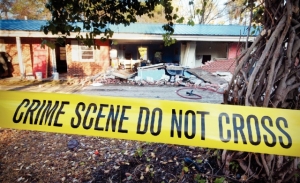Cleanup costs concern county
By Gary Popp
Published in News on June 20, 2011 1:46 PM

News-Argus file photo
This photo shows the aftermath of a methamphetamine lab explosion that destroyed part of the former Goldwater Motel on U.S. 117 South Alternate in March. Paying for the cleanup of such toxic sites has been placed on local governments, and Wayne County officials are looking for ways to find the money to cover the costs, which can run as high as $3,000. Wayne is one of the top counties in the state in terms of meth labs discovered.
State and federal agencies cut off funding for cleaning up methamphetamine manufacturing and dump sites earlier this year, pushing the cost down to local officials.
With the average cost of cleaning up such sites about $3,000, and Wayne County ranking among the top five counties in the state in the number of meth labs, county officials say they could be looking at spending another $45,000 on cleanups before the year is out.
So far this year, there have been 15 meth cleanups in the county.
The cost for a cleanup is so high because of the hazardous materials used in the manufacture of the drug. Private firms are hired to do the work, preventing the spread of corrosive chemicals and harmful airborne agents.
Wayne County Manager Lee Smith said he has not included a line item in the proposed county budget to handle the potential for more cleanups.
"We look at each site on a case-by-case basis," Smith said.
Where exactly the money will come from, Smith said he could not say at this point, but he added that he plans to bring each individual cleanup request before county commissioners.
The county manager said officials will also look to the responsible parties to pay for the cleanups and that the county will consider several options to find the money, from taking out liens on property to garnishing an individual's future tax refunds.
"We will look at every possible option to get (the money) back, because it is not fair to the taxpayers to pay for the cleanups," Smith said.
Officials confirmed that the county's first priority will be to clean up a site and then to locate the money.
Wayne County Emergency Management and Security director Mel Powers agreed.
"The county is not going to take citizen money and run out there and just start paying for every one of these (cleanups)," Powers said.
He added that the county will pursue alternative measures to generate the cleanup funds. One such measure being sought is the local governments reimbursement program offered by the U.S. Environmental Protection Agency that offers to pay back counties a percentage of the money they paid out of pocket.
Even with the costs involved, Powers said public safety will remain a priority and that the sites will be cleaned up, no matter where the money comes from.
"The county is going to ensure that these meth labs are cleaned up the right way, the correct way, and we want to ensure that they are done that way to keep the county safe," he said.
Powers said most of what is found are not active meth labs, but dump sites.
The first methamphetamine cleanup site that fell under the county's responsibility was in early June and included two LP tanks used to store chemicals used in the drug's manufacture.
Powers said the cleanup was a "pick up," which consisted of a private company coming to the site and picking up the tanks and transporting them to its own facility. He said the county had not yet received an invoice for the cost of the cleanup, but said he expected it to be about $750.
Eastern Environmental Management was the company called on for the most recent cleanup and other meth site cleanups in the county.
Troy Ball, a project manager at EEM, said meth cleanups are difficult because each site is unique, depending on the phase of production and the manufacturing method used.
Ball said personnel will first survey the area with meters that check levels of chemicals in the air and the explosive capabilities of the materials at the site.
They will then identify chemicals, put them into containers and remove them from the site.
Ball said his company then must follow EPA and state Department of Transportation regulations during transportation of the hazardous materials.
The company uses out-of-state contractors for final disposal, he said.
Wayne County Sheriff's Office Capt. Richard Lewis said the size of a methamphetamine cleanup site can be as large as a full-fledged working lab, but more commonly the sites are small, compact operations.
"It appears most of the individuals who are cooking today are using what they call the 'shake and bake' method, which is not very many components of a meth lab. It is using a two-liter bottle. It is something that they put all the ingredients in there together, and all that chemical reaction is occurring right there."
Lewis said the Sheriff's Office has sent three deputies to classes to learn how to safely collect evidence at a cleanup site, which requires them to wear special protective suits.
Lewis said he was unsure where the money for future cleanups will come from.
"I am hoping that the federal government is going to come back with the funding to take care of this problem," Lewis said. "I anticipate that taking place. I think it is so bad that they are going to have to come back in and help us."
